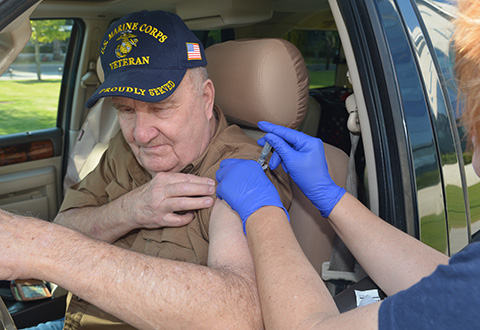By Annette M. Boyle
SAN DIEGO—In the fall, failure of a pharmacy refrigerator and its monitoring system resulted in 1,540 veterans and staff receiving potentially ineffective shots. Since then, the San Diego VAMC has made significant changes to its alert process to prevent a repeat of the problem.
The cascade of events started with a failing refrigerator, which was followed by a series of errors that resulted in a disconcerting but not harmful situation.

Former Marine James McKenzie receives his flu shot at the New Orleans VAMC drive-thru flu shot clinic. In San Diego, some veterans had to be reimmunized because of concerns about proper handling of the vaccine.VA photo
When a pharmacy refrigerator exceeds preset temperatures, an automated alert tells staff when a problem has occurred. That might happen on a very hot weekend with a weak air conditioning system, for instance. Typically, then, cooling systems would be fixed, and any negatively impacted product would be thrown out when staff returned.
In this instance, the initial part of the alert process worked as it should. “The equipment began going out of range on Oct. 2,” recounted Kathleen Kim, MD, MPH, chief of staff and medical director of the VA San Diego Healthcare system. The system sent an alert to the San Diego VA’s engineering and pharmacy groups.
“Though a number of people got the message that the refrigerator was out of temperature range, they were not the right people, and nobody took action,” Robert Smith, MD, director of the VA San Diego Healthcare System told the San Diego Union-Tribune.
Further, the system was not set to continue sending or escalate alerts, so after the initial threshold was passed, no one received additional notices. Staff pulling influenza vaccine doses out of the refrigerator did not register the change in temperature either, as it rose from the target of 36 to 46 degrees into the mid-50s.
Consequently, the problem was not discovered until Oct. 13, and vaccine doses from the refrigerator were administered through the entire period. During most of that time, however, the vaccine retained its potency.
“The vaccine is still good for seven days” after the temperature began to rise, Kim told U.S. Medicine. “Therefore, only vaccines delivered between Oct. 10 and Oct. 13 were considered ineffective.”
According to the U.S. Centers for Disease Control and Prevention (CDC), “exposure of vaccines to temperatures outside the recommended ranges can decrease their potency and reduce the effectiveness and protection they provide.”
During the four days that the vaccines were likely ineffective, 1,300 veterans and 240 VA staff members received immunizations. Kim noted “there would be no negative side effects with the ineffective vaccines, however.”
While the compromised vaccine itself poses no risk, the use of ineffective vaccines did have some negative consequences.
Revaccination of Patients
All individuals who received the vaccine during the period in question were contacted and urged to return from revaccination. As of Jan. 16, 648 patients had been revaccinated at the San Diego VA and 57 received second vaccinations elsewhere, while 71 patients declined to be revaccinated, Kim said.
Beyond the inconvenience to patients and additional work for staff caused by improperly stored vaccine, “errors can also result in the loss of patient confidence when repeat doses are required,” according to the CDC, which further advises that “it is better to not vaccinate than to administer a dose of vaccine that has been mishandled.”
To avoid a recurrence of the problems seen in October, the San Diego VA “has revised its alert rosters to ensure all staff who need to receive the alerts are getting them and all staff have been retrained on the alert system,” Kim said. It has also replaced the broken refrigerator and the temperature monitoring system, which had been monitoring multiple refrigerators.
In addition, to making sure the system is continuously monitored and alerts always receive a response, staff review the temperature alarms at least once a day and “the ICU pharmacist and technician have been tasked with responding to after-hours email alerts with the actions taken,” she noted.
The VA has also ensured that notices continue to be sent for unresolved issues—and that they go up the chain of command, as necessary. “We’ve also modified the notification process to escalate email and text alerts to upper management,” Kim added.
Concern about vaccine quality and effectiveness could have an outsized effect on veterans’ health this year. “We are currently in the midst of a very active flu season with much of the country experiencing widespread and intense flu activity,” according to CDC Director Brenda Fitzgerald, MD.
In the 13 years since the CDC began tracking the intensity of influenza across the country, “this is the first year we had the entire continental U.S. be the same color on the graph, meaning there’s widespread activity in all of the continental U.S. at this point,” said Dan Jernigan, director of the influenza division of the CDC’s National Center for Immunization and Respiratory Diseases. “We’ve seen that some states have even had states of emergency called because of the influenza in their states right now.”
The dominant virus, influenza A, H3N2 is “linked to more severe illness, especially among children and people age 65 and older. When H3 viruses are predominant, we tend to have a worse flu season with more hospitalizations and more deaths,” Fitzgerald said.
